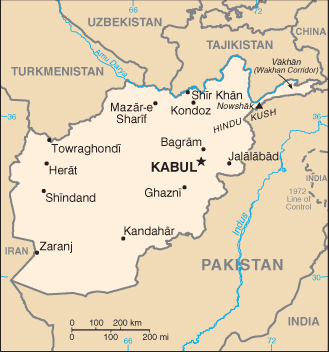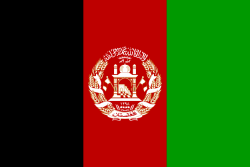Afghanistan
Related Categories:
 Afghanistan Flags
Afghanistan FlagsAfter the defeat of the Taliban, this Afghanistan flag is the latest one to fly over this long-embattled country.
www.flagfocus.info/
Flag, Coat of Arms, Historical Flags.
www.fotw.us/flags/af.html Afghanistan - wikipedia.org
Afghanistan is a mosaic of ethnic groups, and a crossroads between the East and the West. It has been an ancient focal point of trade and migration.
en.wikipedia.org/
Afghanistan's ethnically and linguistically mixed population reflects its location astride historic trade and invasion routes leading from Central Asia into South and Southwest Asia. While population data is somewhat unreliable for Afghanistan, Pashtuns make up the largest ethnic group at 38-44% of the population, followed by Tajiks (25%), Hazaras (10%), Uzbek (6-8%), Aimaq, Turkmen, Baluch, and other small groups. Dari (Afghan Farsi) and Pashto are official languages. Dari is spoken by more than one-third of the population as a first language and serves as a lingua franca for most Afghans, though Pashto is spoken throughout the Pashtun areas of eastern and southern Afghanistan. Tajik and Turkic languages are spoken widely in the north. Smaller groups throughout the country also speak more than 70 other languages and numerous dialects.
Afghanistan is an Islamic country. An estimated 80% of the population is Sunni, following the Hanafi school of jurisprudence; the remainder of the population--and primarily the Hazara ethnic group-- predominantly Shi'a. Despite attempts during the years of communist rule to secularize Afghan society, Islamic practices pervade all aspects of life. In fact, Islam served as a principal basis for expressing opposition to communism and the Soviet invasion. Islamic religious tradition and codes, together with traditional tribal and ethnic practices, have an important role in personal conduct and dispute settlement. Afghan society is largely based on kinship groups, which follow traditional customs and religious practices, though somewhat less so in urban areas.
www.state.gov/
Introduction
About
Contact
Symbols in The News
Interpret this Symbol
AAC
African
AI
Alchemy
Alphabets
Ancient
Animal Symbolism
Architecture
Art
Articles
Astrology
Baha'i
Blissymbolics
Blueprint Symbols
Buddhist
Celtic Symbols
Cemetery
Chinese Symbols
Christian
Circle
City
Codes
Color
Conlangs
Crop Circles
Danger
Da Vinci Code
Designing Logos
Dictionaries
Dreams
Education
Egyptian Symbols
Electrical
Emoticons
Find Images
Fonts
Food
Fraternity
Hamsa
Healing
Heraldry
Hermetic
Highway Signs
Hindu
History
Hobo
Holiday
Icons
iConji
Islamic
Jain Symbols
Japanese, Kanji
Jewish
Justice
Law
Literary Symbolism
Mandalas
Map
Masonic
Math, Number
Meaning of Names
Medical
Middle East
Military
Miscellaneous
Money
Music
Mythology
Native American
Playing Cards
Power
Psychology
QiQiiKhu
Reiki
Religious
Runes, Norse
Sacred Geometry
Scientific
Science Fiction
Sorority
Sports
Symbols in the News
Tattoos
ThirteenSymbols
Tree of Life
Ursprache
Videos
Visual Languages
Weather
Web Codes
Wicca
Words
Writing Systems
Braille
Coinherence
Coptic
Cuneiform
Easter Island
Etruscan
Happy Human
Hebrew
Kokopelli
Linear B
Lotus
Love Symbols
Mandorla
Moon Alphabet
Nine Pointed Star
Om
Oz
Phonetic
Scarab Beetle
Silent
Theosophy
Unifon
About
Contact
Symbols in The News
Interpret this Symbol
AAC
African
AI
Alchemy
Alphabets
Ancient
Animal Symbolism
Architecture
Art
Articles
Astrology
Baha'i
Blissymbolics
Blueprint Symbols
Buddhist
Celtic Symbols
Cemetery
Chinese Symbols
Christian
Circle
City
Codes
Color
Conlangs
Crop Circles
Danger
Da Vinci Code
Designing Logos
Dictionaries
Dreams
Education
Egyptian Symbols
Electrical
Emoticons
Find Images
Fonts
Food
Fraternity
Hamsa
Healing
Heraldry
Hermetic
Highway Signs
Hindu
History
Hobo
Holiday
Icons
iConji
Islamic
Jain Symbols
Japanese, Kanji
Jewish
Justice
Law
Literary Symbolism
Mandalas
Map
Masonic
Math, Number
Meaning of Names
Medical
Middle East
Military
Miscellaneous
Money
Music
Mythology
Native American
Playing Cards
Power
Psychology
QiQiiKhu
Reiki
Religious
Runes, Norse
Sacred Geometry
Scientific
Science Fiction
Sorority
Sports
Symbols in the News
Tattoos
ThirteenSymbols
Tree of Life
Ursprache
Videos
Visual Languages
Weather
Web Codes
Wicca
Words
Writing Systems
Braille
Coinherence
Coptic
Cuneiform
Easter Island
Etruscan
Happy Human
Hebrew
Kokopelli
Linear B
Lotus
Love Symbols
Mandorla
Moon Alphabet
Nine Pointed Star
Om
Oz
Phonetic
Scarab Beetle
Silent
Theosophy
Unifon

